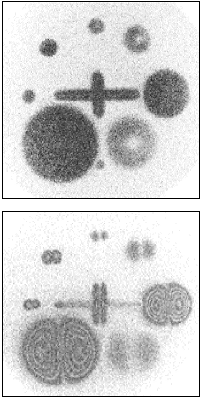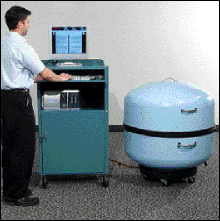
Putting Tires to the Test
Hank Hogan
Eugene Shaw, president of Lake Orion, Mich.-based L-Ray, wants to make sure that when the rubber meets the road, it won't stay there. The company has introduced an optically based tire-testing system that allows manufacturers to detect anomalies. Detecting and removing anomalous tires should boost traffic safety, something consumer groups have been urging the National Highway Traffic Safety Administration to do via mandated testing.

A new technique for testing tires, called differometry, cuts testing time and produces easy-to-understand results (top), compared with the conventional shearography technique (bottom).
These requests will not be ignored, according to Shaw. "Eventually ... every tire is going to have to be tested with some form of nondestructive testing equipment."
However, this is not the case today. One problem, Shaw said, is that the current standard test takes up to 20 minutes per tire and costs as much as $10. The test is based on shearography, a technique developed at Oakland University in Rochester, Mich., more than 25 years ago. Besides other drawbacks, shearography produces confusing and hard-to-interpret results because all anomalies appear as laterally displaced images.
In contrast, the L-Ray approach cuts the testing time to 26 seconds and the cost to less than 50 cents, Shaw said. It also produces easy-to-understand results. L-Ray's machine makes use of proprietary algorithms, four cameras instead of one, and 16 laser diodes instead of a single light source. The use of multiple cameras and lasers is possible only because of a sharp drop in the cost of these parts over the past few years.
"The components cost about $100,000" when development of the new tire tester began in 2000, he said. "Today they cost just a few thousand."

A new tire testing system promises to quickly and inexpensively test tires to weed out what the industry calls anomalies, the most common of which is ply separation. This is spotted by placing tires in a vacuum chamber. The change in tire topology due to a pressure change is manipulated to produce a clear image.
Besides carrying a smaller price tag, the new cameras are much smaller than the old lunch-box-size ones. Manufactured by Lumenera Corp. of Ottawa, they are the size of a pack of cards. Camera shrinkage is important because, in the L-Ray approach, four cameras have to fit inside a tire. World Star Technologies Inc. of Toronto supplies the laser diodes.
The proprietary algorithms are based on "differometry." In operation, tires are placed inside a chamber within the machine. The four cameras capture images of the inside of the tire; thanks to carefully designed optics, each camera can handle one tire quadrant. The system pulls a slight vacuum in the chamber. Additional images are then taken and results displayed.
The most common anomaly is one where the layers, or plies, of a tire separate. Because of the pressure change, those separations increase and cause a change in tire topography. That's picked up when the differences between the two images are processed by the algorithms into an easy-to-comprehend output.
"With differometry, it shows you actually where the anomaly is, what size it is, how intense it is by a change of color," Shaw said.
After years of development and several million dollars in expense, the tire-testing product is in production and being deployed. Besides testing the 190 million or more passenger tires shipped in the US every year, the system could be used to test recapped or retreaded tires. Rehabilitated tires are used for the US Postal Service fleet as well as in trucking, military and aerospace applications.
Aviation, in particular, could make good use of a fast, accurate and inexpensive recapped tire test because of a common practice. "They don't retread them once, they retread them again and again and again," Shaw said. "But they inspect before and after they retread. Because of the extensive testing and a proven carcass, retread airplane tires are better and sometimes have more value than brand-new tires.
Published: September 2004